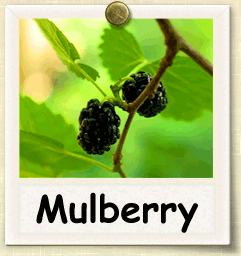|
Home > Guides > Fruits > Mulberry |
|
How to Grow Mulberry | Guide to Growing Mulberry |
|
|
|
|
| |
 |
|
Overview |
|
|
|
|
|
| |
|
| |
The Fruit from the Mulberry Trees are similar in appearance to an elongated blackberry or raspberry and have a sweet flavor. Easily grown, this tree makes an attractive, fast growing landscape tree. |
|
| |
|
|
| |
Growing Guide
GROWING NOTES
Mulberry will grow into a medium-sized tree 20-30 feet tall, and produce pale green blossoms from mid spring. Under ideal conditions it can grow very quickly. It produces tasty berries which can be collected and eaten, in addition to the leaves which are used for tea.
Mulberry seeds can be difficult to germinate, and may naturally show low rates of germination. Seeds require approximately 90 days of cold, moist stratification which should be initiated in mid to later winter. Prior to stratifying,seeds should be soaked in water for 4 days, replacing water every 2 days. To stratify, place seeds onto paper towel, moisted, and fold over. Place into resealable baggie and place into refrigerator. Label bag and check every week or so to make sure towel remains moist. Remove and immediately sow any seeds that begin to germinate.
Mulberry likes full sun and slightly acidic (pH around 6.0), moist soil that is deep enough to support its potentially extensive root structure.
MAINTAINING
At the end of the stratification, sow indoors in containers and keep well moistened until seeds begin to germinate then cut back on the water slightly. Gradually expose to increasing amounts of sunlight and do not transplant outdoors til the last frost of the season has passed.
|
|
| |
|
| |
Heirloom seeds are the gardeners choice for seed-saving from year-to-year. Learning to save seeds is easy and fun with these books. Before you harvest, consider which varieties you might want to save seeds from so that your harvesting practice includes plants chosen for seed saving. Be sure to check out our newest seed packs, available now from Heirloom Organics. The Super Food Garden is the most nutrient dense garden you can build and everything you need is right here in one pack. The Genesis Garden s a very popular Bible Garden collection. The Three Sisters Garden was the first example of companion planting in Native American culture. See all of our brand-new seed pack offerings in our store.
|
|
| |
|
|
| |
Harvesting Guide
HARVESTING
Mulberry leaves must be harvested in spring and summer, as they begin to get tough and lose their flavor in the late summer and fall. The berries can be collected and enjoyed in the fall. Once established, Mulberry will be productive for 15-20 years or more.
SAVING SEEDS
|
|
| |
|
|
|
| |
|
|
|
|
|
| You can find this variety in the following Seed Packs: |
|
|
|
| Click the packs below to see some of our other wonderful products |
|
|
|
|
|
|
|